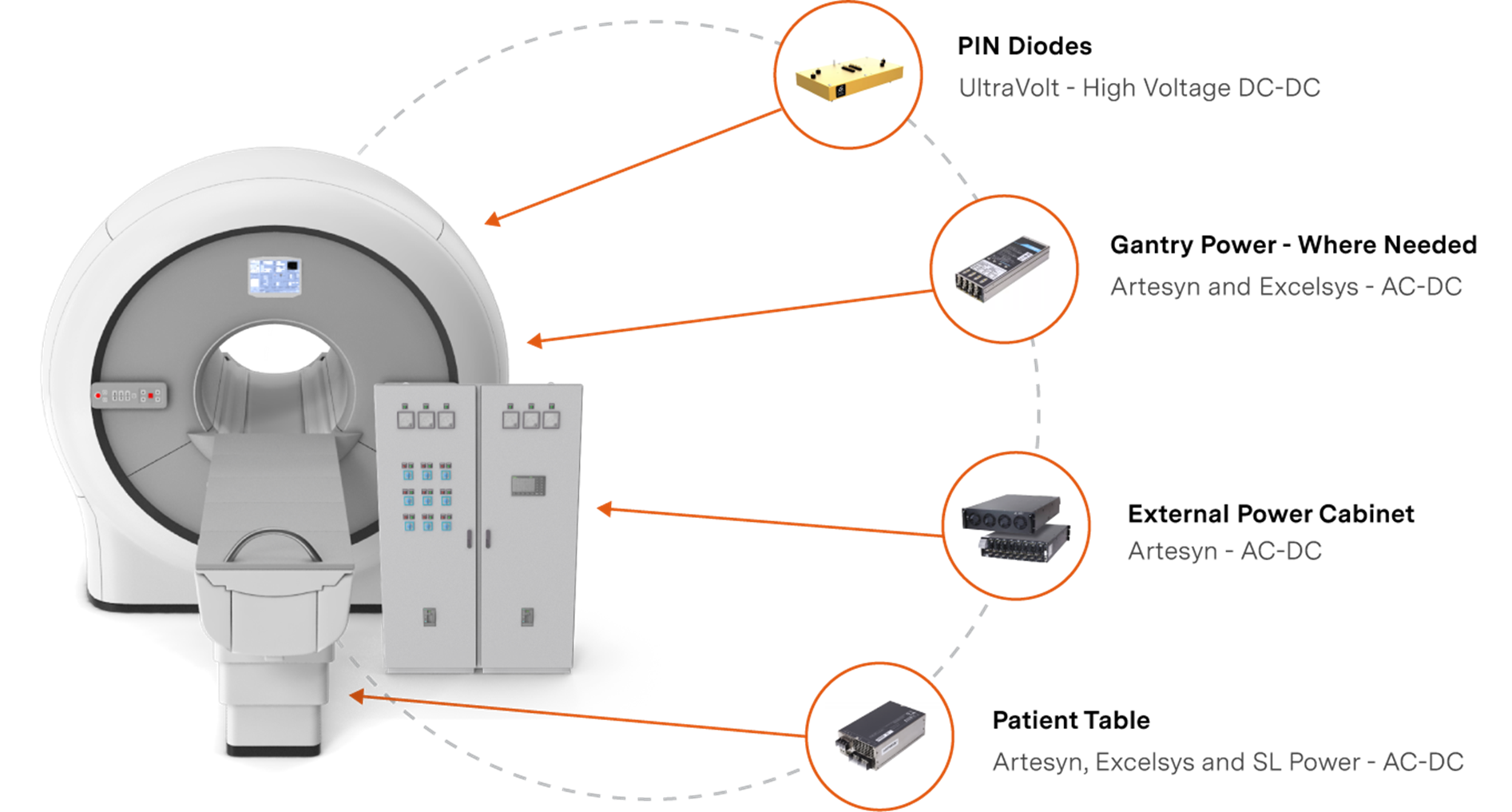Safeguarding Patient Outcomes - The Critical Role of Voltage Regulation in Healthcare and Life Sciences Equipment
投稿 8月 29, 2024 によって Conor Duffy
The accuracy of medical diagnostics and the effectiveness of treatments depends on the stability of voltage supplied to medical systems
Whether it’s the precision of surgical lasers, the clarity of images from a magnetic resonance imaging (MRI) scan or the detection of molecules in liquids, advanced medical and life science systems that enable better patient outcomes through healthcare diagnostics and treatment all have one thing in common - the need for stable system voltages. Advanced Energy has been developing customizable and modular power supplies for medical applications for almost 40 years, and is at the forefront of delivering power supply technologies essential to ensuring optimized performance and tightly regulated outputs across the spectrum of healthcare technologies.
Medical Imaging and Electrosurgery
From X-rays (the oldest and most frequently used imaging technique) to the latest artificial intelligence (AI) MRI scans and points between - computed tomography (CT) scanners, positron emission topography (PET)/ single-photon emission computed tomography (SPECT) and ultrasound – medical imaging systems provide critical analysis and diagnostics for healthcare professionals.
After diagnosis, the latest electrosurgery systems offer precise and efficient methods for tissue cutting, coagulation and ablation. These systems use various methods to target, heat and cut tissue. They include high-intensity focused ultrasound (HIFU), microwave ablation, pulsed electric fields (PEF), pulsed field ablation (PFA), and radiofrequency (RF) ablation. They also include medical laser technologies for medical and aesthetic treatments. These treatments range from skin rejuvenation and depilation to cataract removal and retinal repair. They also involve laser-based surgery for ablation, dissection and hemostasis.
Built on advanced and complex electronics platforms, these systems demand highly accurate management of on-board voltages to operate efficiently, effectively and with the best possible results for patients.
Medical imaging systems provide critical analysis and diagnostics for healthcare professionals. They include X-rays, MRI scans, CT scanners, PET/SPECT and ultrasound. These systems use advanced and complex electronics that need stable system voltages to operate efficiently and effectively. Stable voltage ensures clear and detailed images, optimal penetration, minimal distortion and accurate detection. It also reduces the patient’s radiation exposure and protects the equipment from wear and tear.
In terms of delicate electrosurgery, studies show that even minor deviations in system voltages can lead to imprecise targeting or inadequate treatment, causing damage to healthy tissue, compromising patient safety and procedure success.

That’s why HIFU requires meticulous voltage control to accurately focus ultrasound beams. Microwave and RF ablation demand consistent voltages to ensure that the radio waves generated deliver the minimum energy needed to heat and destroy tumor cells. PEF and PFA technologies rely on precise voltage control for the short bursts of high-voltage electric fields to disrupt cellular membranes for tumor treatment or cardiac ablation. The same is true for aesthetic lasers, ophthalmic lasers and surgical laser systems. In these laser systems, the ability to fine-tune the laser’s power, pulse and wavelength through precise voltage control ensures consistent energy output for accurate targeting and optimum results with minimized collateral tissue damage.
Life Sciences
Today’s medical developments are supported and driven by life sciences organizations that provide the research and development capabilities needed to pioneer new treatments and analyze results from patient diagnoses. These organizations also rely on a host of advanced instruments where precise voltage control is a critical success factor.
Analytical equipment, including mass spectrometers (MS), scanning electron microscopes (SEM) and electroporation systems, all rely on consistent voltages to perform at their best. Voltage instability can compromise the sensitivity and specificity of equipment measurements, directly impacting the accuracy and dependability of these technologies and negatively impacting research outcomes and clinical diagnostics.

For instance, a stable voltage is critical for the accurate detection and quantification of molecules in complex mixtures within liquid chromatography-mass spectrometry (LC-MS). The accuracy of mass-to-charge ratio measurements - a fundamental aspect of mass spectrometry analysis - hinges on consistent power supply outputs. Scanning electron microscopes depend on precise voltage control for high-resolution imaging of sample surfaces at the nanometer scale. Fluctuations in voltage can blur images, obscuring vital details necessary for material science, biology and quality control analyses. Electroporation requires exact voltage parameters to temporarily permeabilize cell membranes without causing permanent damage. The success of electroporation relies on the ability to maintain specific voltage levels. Inconsistent voltages can lead to cell death or ineffective transfection, impacting research validity and therapeutic applications.
Conclusion
Choice of power supply and power conversion technologies can have a significant performance impact on a wide variety of medical diagnostic and treatment and life sciences equipment. Among the many criteria that medical designers need to consider as they develop their power architectures is how best to deliver precise, repeatable and reliable voltage outputs needed for accurate diagnosis and the targeted delivery of treatment that ensures the best patient outcomes. In addition to the examples given above, the same need for tightly regulated outputs exists in many other areas of healthcare including vital sign monitors, infusion pumps and dialysis machines.
What’s more, the importance of maintaining stable voltages extends beyond image quality or control of radiation to which a patient is exposed. Because voltage fluctuations can put undue stress on electronic components and can accelerate wear and tear, accurate voltage regulation can contribute to the reliability and longevity of medical imaging equipment. This is a fundamental issue for equipment that can incur significant capital costs, is expected to operate for many years and where operational downtime is not only expensive but has a direct impact on patient health.
Selecting the correct power source for your application is crucial to ensure the optimal performance of your equipment. At Advanced Energy, we provide specialized and reliable products that meet various needs such as portability, digital communication capabilities, and regulatory compliance challenges. With an increase in regulatory complexity, it is very important to pick a partner that understands your needs. We can help you navigate these complexities and provide solutions that ensure your sensitive system electronics are not subjected to factors such as vibration and air disturbances.
Bolster medical equipment with Voltage Regulation. Connect with Advanced Energy today.
Conor Duffy
Advanced Energy
Conor Duffy has more than 20 years of experience across General Management, Sales, Product Management & Technical Marketing roles in the in the Power Supply and Industrial Electronics industries. He joined Advanced Energy in 2017 as part of the acquisition of Excelsys Technologies where he was then CEO. Conor holds an MSc. in Technology Management from Smurfit Business School, University College Dublin, a BSc. Electrical & Electronic Engineering from University College Cork and has also completed Executive Leadership Programs at IESE Business School, Barcelona and IMD in Lausanne.
その他の投稿 Conor Duffy

